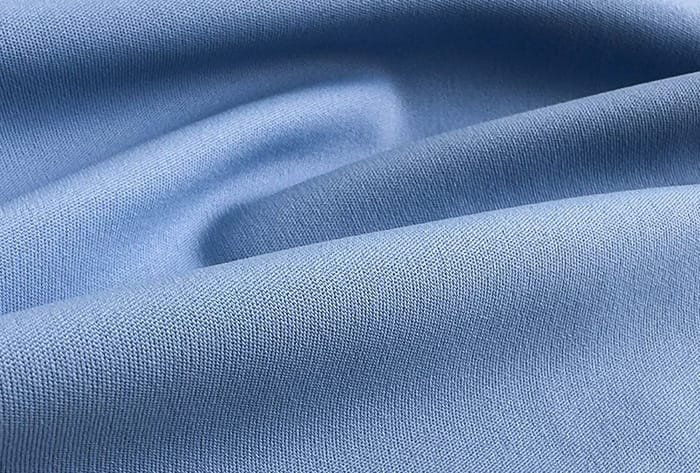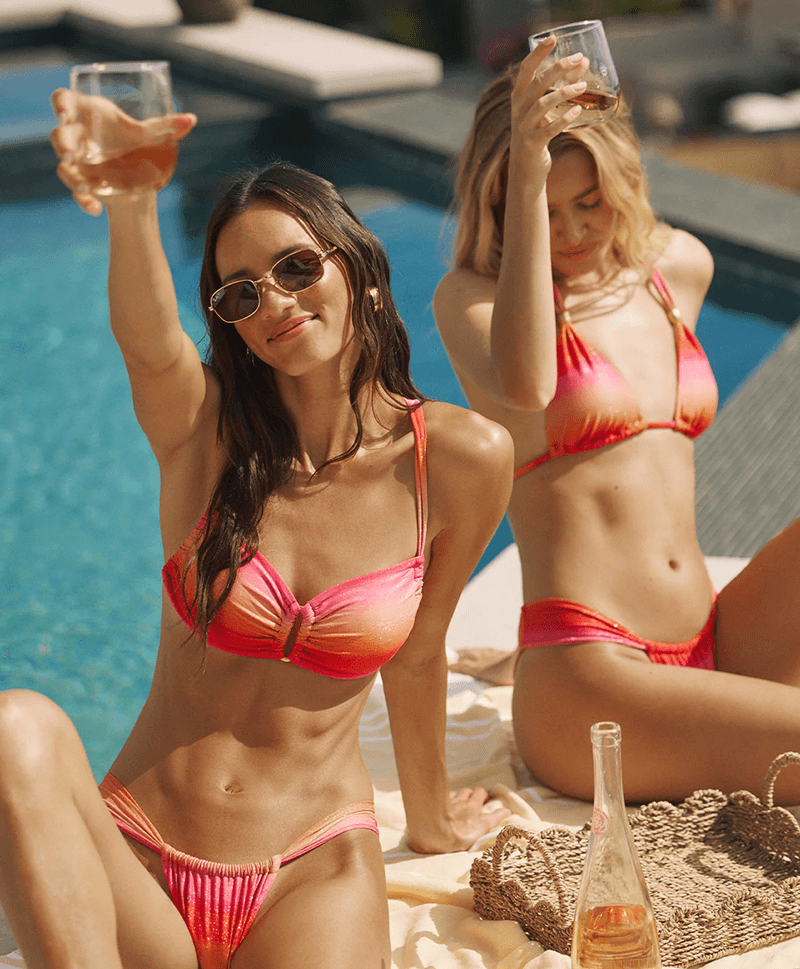Have you ever wondered how your favorite bikini is made — from a simple design sketch to a perfectly fitted garment that looks effortless on the beach?
Behind every high-quality bikini lies a process that blends creativity, craftsmanship, and advanced textile technology.
In this guide, we’ll take a technical look inside the bikini manufacturing process, showing how professional swimwear makers transform raw materials into stylish, functional swimwear worn worldwide.
Understanding Bikini

Swimwear is more than fashion — it’s freedom. The modern bikini, first introduced by Louis Réard in 1946, changed how women experienced the beach, turning confidence and self-expression into wearable design.
Today, the bikini has become a global staple that combines aesthetic appeal, body support, and fabric performance. Each piece reflects decades of progress in pattern engineering, elastic technology, and sustainable material science.
Let’s explore how a bikini takes shape — from fiber to finished product.
From Yarn to Fabric
Fiber to Yarn Transformation
Bikini manufacturing begins with specialized synthetic or recycled fibers such as nylon, polyester, or ECONYL® regenerated nylon. These fibers are extruded, stretched, and spun into fine elastic yarns that offer light weight, strength, and UV resistance — the essential properties of swimwear performance.
Knitting and Construction
Through warp knitting or circular knitting, yarns become stretch fabrics that contour smoothly to the body. The structure determines recovery rate, breathability, and softness — characteristics critical to comfort in movement.

ScienceDirect
Fabric Finishing
Fabrics are treated for anti-pilling, chlorine resistance, UV protection, and colorfastness. These finishes extend the bikini’s lifespan, preventing fading and sagging even after exposure to salt water and sunlight.
Before cutting, fabrics undergo tensile and stretch-recovery testing to guarantee quality consistency across production batches.
Designing the Perfect Bikini
A bikini’s success starts long before the first stitch. Professional design development balances creativity, comfort, and technical performance.
- Define Your Brand and Audience – Identify whether your market is luxury resort, sustainable eco-line, or sporty performance wear.
- Visualize the Silhouette – Choose shapes and coverage levels that express your brand: triangle, bandeau, halter, or high-waisted.
- Perfect the Fit – Accurate body measurements for bust, waist, hips, and torso length ensure reliable grading and wearer confidence.
- Add Signature Details – Trims, textures, prints, and hardware reflect brand identity and differentiate your collection.
- Prioritize Comfort and Functionality – Use soft linings, breathable stretch fabrics, and supportive elastics that maintain shape through movement.
- Prototype, Test, and Refine – Fit samples are evaluated on live models, adjusted, and retested until achieving a balanced look and flawless fit.
Effective design merges aesthetic innovation with engineering accuracy, setting the tone for the entire production process.
Types of Bikinis
Bikinis come in many silhouettes, each designed to flatter different body types and express unique styles. From timeless classics to modern statements, here are some of the most popular bikini types in 2025.
Triangle Bikini

The most iconic bikini style, featuring adjustable string ties and triangular cups.
Its minimal design offers customizable fit and classic appeal, making it a go-to choice for beachwear brands worldwide.
Bandeau Bikini

A strapless style that highlights the shoulders and collarbone. Perfect for achieving minimal tan lines, the bandeau bikini combines sophistication with simplicity and is often enhanced with ruching or removable straps for better support.
Halter Bikini

Featuring neck ties or halter straps, this design provides excellent lift and support for the bust.
It’s ideal for active beach days and remains a favorite for both sporty and elegant swimwear collections.
Underwire Bikini

Structured with built-in underwires for enhanced support and shaping.
This style mimics the comfort of a bra, offering both functionality and style for women seeking confidence and contour in their swimwear.
High-Waisted Bikini

A vintage-inspired favorite that sits above the natural waistline, offering more coverage and a flattering silhouette.
Its retro charm appeals to customers looking for comfort and timeless elegance.
String Bikini

Known for its delicate side ties and minimal coverage, this style embodies effortless sexiness.
Lightweight and adjustable, it’s popular in custom swimwear lines that value flexibility and personalization.
Push-Up Bikini

Designed with padded or molded cups to enhance curves and lift.
The push-up bikini merges functionality and fashion, making it a bestseller among brands focusing on glamour and body enhancement.
Sporty Bikini

Built for movement and performance, the sporty bikini features secure fits, racerback straps, and functional elastic bands.
It’s perfect for active customers who value comfort during swimming, surfing, or beach workouts.
Micro Bikini

A daring, ultra-minimal design that uses smaller fabric panels for bold exposure.
This eye-catching style caters to niche fashion markets and is often featured in high-fashion or luxury resort collections.
One-Shoulder Bikini

Characterized by its asymmetrical neckline, the one-shoulder bikini combines modern aesthetics with functional design.
It offers a contemporary twist that appeals to fashion-forward brands seeking something unique and trend-driven.
Anatomy of a Bikini
The bikini exterior may look simple, but each component plays a vital role in its fit, comfort and durability.
Understanding these key components helps brands and designers refine construction details to improve performance and aesthetics.
1. Bikini Top

The top part of a bikini, designed to support and shape the breasts.
It can come in a variety of styles – triangle, bralette, halter or steel – and often includes padding, lining or elastic.
2. Bikini Bottom

The lower part that provides coverage and structure around the waist and hips. Styles vary from cheeky and high-cut to full coverage.
3. Straps

Used to secure the bikini top and sometimes the bottom, straps may be adjustable, tie-up, or fixed. Their placement and elasticity are key to ensuring a secure yet comfortable fit.
4. Elastic Bands
Hidden within seams or waistlines, elastics provide flexibility and hold. They maintain the bikini’s shape during movement and help prevent sagging or slipping when wet.
5. Lining
An inner layer that adds comfort, opacity, and support. High-quality bikinis use soft, quick-drying linings to enhance wearability and prevent transparency after swimming.
6. Seams

The connecting stitches that join panels together. Seam type affects both comfort and strength—flatlock and overlock seams are commonly used to ensure durability without irritation.
7. Gusset
A small triangular or oval panel inserted in the crotch area of bikini bottoms. It improves comfort, hygiene, and fit, especially for active or all-day wear.
8. Closures
Fastenings such as hooks, clasps, or ties that help secure the bikini. Metal or plastic closures are chosen for water resistance and rust-proof quality, while tie closures allow easy adjustability.
9. Hardware & Accessories

Decorative or functional elements like rings, sliders, or logo charms. These small details elevate the bikini’s look and branding appeal, giving it a signature touch.
10. Branding & Labels
Every professional bikini includes brand identifiers—woven tags, printed care labels, or heat-transfer logos. These elements reinforce brand identity and communicate quality assurance to customers.
Choosing Quality Fabrics

Fabric selection is one of the most critical steps in bikini manufacturing. The right material determines not only the look and feel of the bikini but also its durability, comfort, and performance in different environments.
Professional bikini manufacturers carefully test each fabric for stretch recovery, UV resistance, colorfastness, and breathability to ensure consistent quality across every collection.
Nylon-Spandex Blend
The most widely used fabric in bikini manufacturing, known for its smooth texture and superior stretch. It molds beautifully to the body and provides excellent comfort, making it ideal for fashion-forward swimwear.
Polyester-Spandex Blend
A durable alternative that retains color and shape even after frequent exposure to chlorine and sunlight. It’s perfect for brands that prioritize long-lasting performance and vibrant prints.
Recycled Nylon (ECONYL®)
A sustainable choice made from regenerated ocean and industrial waste. ECONYL® offers the same quality as virgin nylon but with a much lower environmental footprint — perfect for eco-conscious swimwear brands.
Recycled Polyester (REPREVE®)
Made from post-consumer plastic bottles, REPREVE® fabrics provide strength and flexibility while supporting sustainability goals. It’s commonly used in private label swimwear collections seeking eco-certification.
Textured Fabrics
These tactile materials add depth and visual interest to minimalist designs. They offer a luxurious feel and are trending in boutique bikini lines for their stylish, body-flattering look.
Shiny & Metallic Fabrics

Ideal for statement or resortwear collections, these fabrics feature glossy or reflective surfaces that catch the light beautifully. They’re often paired with simple silhouettes to highlight texture and sheen.
Mesh and Powernet Lining
Used for structure and support, especially in underwire or high-performance bikinis. Powernet linings enhance stability and fit, ensuring the bikini maintains shape during movement.
What Are the Best Materials for Swimwear?
Pattern Making and Cutting
Pattern making transforms creative sketches into technical blueprints.
Each pattern piece defines the bikini’s fit, coverage, and movement.
Custom vs. Ready-Made Patterns
- Custom patterns are drafted from a brand’s specific size chart and design measurements.
- Ready-made patterns are standardized templates adjusted to match brand preferences for speed and consistency.
Pattern Development Steps

- Draft a base block for the bikini top and bottom.
- Modify coverage, strap position, and neckline according to design.
- Add seam allowances, notches, and elastic placement marks.
- Digitize the pattern for CAD layout and precise cutting.
Cutting Techniques
Fabrics are laid flat, aligned with the stretch direction, and cut using rotary blades or laser systems to achieve clean, distortion-free edges.
Digital marker layouts reduce fabric waste and ensure print alignment for patterned materials.
Sewing and Assembly
Sewing is the most skill-intensive stage of bikini manufacturing. Stretch fabrics demand precision equipment and steady craftsmanship.

Preparation
All components — fabric panels, linings, elastics, and trims — are inspected, labeled, and paired by size.
Stitch Types in Bikini Manufacturing
Bikini assembly requires specialized machinery capable of handling elastic materials.
Unlike ordinary garments, swimwear must stretch, recover, and resist deformation.
The following stitches are commonly used to sew bikinis:
- Zigzag Stitch: Maintains flexibility along edges and seams.
- Flatlock Stitch: Creates smooth, flat joins ideal for active styles.
- Overlock (Serger) Stitch: Prevents fraying and adds durability.
- Coverstitch: Produces neat hems and waistlines.
Understanding Swimwear Stitch Types
Assembly Process
- Join main panels and attach lining.
- Insert elastic bands around bust, waist, and leg openings for fit and recovery.
- Add straps, ties, and hardware components.
- Finish edges with coverstitching for comfort and appearance.
Quality Checks During Assembly

At every stage, each piece is checked for:
- Seam alignment and even tension
- Smooth elastic integration
- Clean, consistent stitches
- Proper sizing and symmetry
Only after passing these internal checks does the bikini move on to the next stage — finishing and final inspection.
Bikini Measurement Points
Accurate measurement guarantees consistent sizing and wearer satisfaction.
Key checkpoints include:
- Bust & Underbust: Define cup fit and top support.。
- Waist & Hips: Determine bottom silhouette and balance.
- Torso Length: Ensures proportional fit across sizes.
- Leg Opening: Controls comfort and visual leg length.
- Strap Length: Allows adjustability for different body heights.
- Cup Depth: Dictates coverage and shaping.
- Front & Back Rise: Maintain comfort and aesthetic proportion.
These data points guide both pattern grading and final quality control.
The Art of Printing on Bikinis

Printing turns functional fabric into fashion.
Modern technologies allow unlimited color, pattern, and branding possibilities without sacrificing performance.
Heat Transfer Printing
Heat transfer printing applies pre-printed artwork, logos, or small motifs onto the fabric using heat and adhesive films.
Best for branding elements or localized designs rather than all-over prints.
Sublimation Printing
Sublimation printing transfers dye onto polyester-based fabrics using heat and pressure, bonding the ink into the fibers instead of sitting on the surface.
Best for:
Sporty and performance bikinis requiring high durability.
Full-body printed designs or gradient effects.
Digital Printing
Digital printing uses advanced inkjet technology to apply designs directly onto the fabric surface.
Best for:
Complex patterns, gradients, or photographic designs
Small-batch production and personalized prints for private-label bikinis.
Best Printing Methods for Swimwear
Finishing, Quality Control, and Packaging
After sewing and printing, bikinis move through final inspection to ensure every piece meets export-grade standards.
Finishing Touches
- Trimming excess threads
- Ironing for shape retention
- Adding branded hardware or logo transfers
Quality Control
Every bikini is checked for:
- Seam alignment and strength
- Stitch uniformity
- Elastic recovery
- Visual symmetry and size labeling accuracy
Defective pieces are corrected or removed before packing.
Branding and Packaging
High-end bikini manufacturers provide customized branding options:
- Woven or heat-transfer labels
- Logo-engraved hardware
- Custom or Recyclable packaging
Well-presented packaging protects the product during shipping and reinforces brand value.
Conclusion
Bikini manufacturing is the art of transforming technical precision into effortless beauty.
From advanced fibers to final stitching, each step demands expertise and attention to detail.
Whether you’re a designer, start-up brand, or sourcing professional, understanding this process reveals the care, testing, and technology behind every bikini — proof that true craftsmanship never goes out of style.

